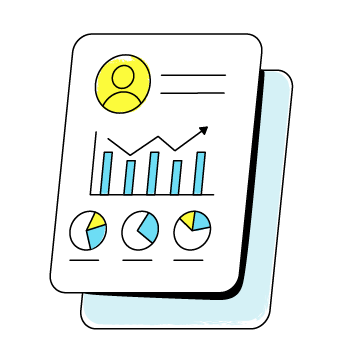24. February 2022
This Strategy Is Key to Developing Leaders

In just about any organisation, great leadership makes all the difference. That's why developing leaders while emphasising leadership and management development is crucial for companies at just about any stage. It’s also what I want to address and cover in today’s article.
In this article, I’ll take you through some common definitions and tactics your organisation can employ, while hearing from Personio’s own Leadership Development Manager, Christian Westin, about why many organisations simply aren’t taking the time to strike the right balance.
Contents
What is Leadership Development?
Generally speaking, we can look to leadership development as consisting of the processes, opportunities, and framework that help leaders grow within the context of a unique organisation. It’s about ensuring that your company’s leaders have the ability to succeed as exactly that: leaders.
Why Does Developing Leaders Matter?
Developing leaders in your organisation matters because if your leaders are veering off course, there is a distinct likelihood that they can take their team, or the entire organisation, along the ride with them.
Let’s turn to Christian Westin to gain a bit of his insight on this matter: "My view, and the view of Personio, is that our leaders are magnifiers. Anything they do has an outsized impact on the entire organisation. So, it is particularly important to be mindful of how you are developing leaders and to ensure that you are doing it right."

Let’s first stop to hone in on that idea of leaders as magnifiers. Taken this way, leaders not only have an effect but an incredible amount of impact on everyone around them. That may trickle down to their reports, but it also moves laterally between leaders.
For organisations that have grown quickly or have a rather insulated team of leaders, this can lead to one bad apple spoiling the bunch over time. An insulated leadership team will, with little doubt, cause strife in an organisation due to a lack of (or resistance toward) development.
So, in the context of an organisation growing rapidly or competing on multiple fronts, this may put leaders under an even greater amount of pressure to perform. So, developing should be looked at the same way as nurturing them — ensuring both they and the organisation can succeed.
Nurture Your Natural Leaders with Strategic Performance Management

Nurture current and potential leaders in your organisation with streamlined feedback and assessment forms that speak to your company’s culture, values, and processes. Learn more by clicking below.
Increased Performance With PersonioThe Big Question: How Do You Develop Leaders?
I really wanted to dive into the crux of the matter: We know that developing your leadership suite is important, but how do you even go about doing it? The first step is understanding the current state of leadership in your org.
Step One: The State Of Leadership
This is your baseline, your flashpoint, or your ‘moment of truth’ which tells you where things stand and how you should regard them. This could be done through:
An organisation-wide engagement survey
Team-specific pulse surveys for team-by-team results
One-on-one interviews with both leaders and reports
Anonymised and open-ended feedback collection
But, this is where Christian urges caution, “Organisations should seek to constantly ‘take a picture’ of leadership in their organisation, because it isn’t enough to do it once and have that be the standard of leadership forever…they should constantly be measuring and understanding the fluid and evolving nature of leadership, at all times,” he explains.
In my reading, that doesn’t mean constantly asking your workforce how they feel about their leaders on a week-to-week basis, but to make leadership evaluations cyclical in some way, shape, or form. Running engagement surveys, specifically devoted to leadership, on a quarterly basis, for instance.
Step Two: Learning Design
The next step would be to design and develop learning and development opportunities for leaders, to enhance skills and abilities within a given workforce. The mix here is crucial, and can often be a stumbling block for many organisations (more on that one later, though).
A more tailored mindset here is critical: You may want to consider different career pathways for different leaders, trying to figure out and iterate on what offerings would appeal to leaders of different types (and offering journeys that account for them).
Let’s quickly compartmentalise what we’ve covered so far — when it comes to developing leaders, here are three steps to start:
Determine the current state of leadership
Start designing learning and training plans
In tandem with step two, design pathways for different leaders
Step Three: Tailor & Personalise
When it comes to developing leaders, Christian details one of the most important things to note: “Companies have their own unique makeup, and leaders need to adapt and grow within that unique context,” he stresses.
I can’t help but think of the many positions a company may find itself in. They may be working with the leaders they currently have, looking to hire externally to find new inspiration for leadership, or simply filling out their bench. Leaders don’t come one way, all of the time, they are incredibly different and their success is defined by context.
An essential element to leadership and management development is exactly that: avoiding a one-size-fits-all approach that tries to put your leadership efforts into a box. Leadership development will always matter, but it may matter in different ways, including companies:
In different stages of growth
Of differing structures and makeup
Existing in a variety of industries
What has worked and what will work in future, from a leadership perspective, is bound to change and the requirements will change, too.
Adding in layers, adding in new leaders, adding in leaders of leaders or leaders of various domains, certain leaders may become more motivational rather than operational, which is why different leadership pathways become critical.
How Do You Build A Leadership Development Plan?
Speaking of pathways, planning, and building a leadership and development framework, I asked Christian to identify where he feels most companies get leadership development wrong.
In his opinion, t comes down to balance: 70/20/10, this is the rule of thumb when it comes to leadership development planning:
100% | Discipline | Explanation |
|---|---|---|
10% | Formal Training | Classroom-based, online courses, self study, credential-based work. |
20% | Learning From Others | Coaching, professional groups, mentorship, 360º feedback, career discussions, one-on-ones. |
70% | On-The-Job Training | Shadowing, action learning, moving into new projects across functions/departments, new assignments. |
In Christian’s experience: “Most companies get the required ratios mixed up — spending 70% of their allotted time on formal training. Paying for someone to attend a seminar should not make up the bulk of your time developing leaders.”
Ultimately, building a plan means focusing mainly on how leaders become better on the job, not in theory — of course, theoretical work, seminars, and even micro-learning opportunities can augment what’s learned on the ground, but that really has to be the focus.
For this to succeed, the key is tailored planning. “If you can ensure that each leader has their own development plan, then they can get very custom learning that is readily available,” Christian explains.
It also helps move any formal training programs, those that make up the smallest portion of developing leaders, into real practices. Otherwise, they may be forgotten or become bound to a notebook and not employed.
The key here, as I found it, was to have a development plan and to keep it accountable. That means accountability for the leader, trickling down to their reports, as well as accountability for HR. Leadership development never rests solely on the leader themselves, but on the HR function setting them up for success.
Of course, it’s a two-way street. An uncooperative leader may never make the most of their development plan or suggested training, but the fact remains: If the mix (the ingredients, let’s say) is wrong, it ruins the leadership recipe.
How Do You Assess Leaders Based On That Plan?
Hand in hand with developing leaders is also evaluating leaders. This is where things can get a bit murky, on where HR teams and organisations can struggle with keeping leaders accountable or sticking to the plan.
Let’s think about it two ways: On an individual level, having clear KPIs against which performance is measured is key (these might be role-specific metrics). But, that doesn’t have to be limited to business outcomes or KPIs in a traditional sense.
What you may also want to focus on are what Christian calls “leadership-specific requirements.” Depending on the pathway that leader is on, what kind of expectations (actions, behaviours, skills, etc.) would be required of them at certain stages.
That might include crafting an evaluation scale or grading curve that accounts for:
Strategic thinking skills
People management and performance
Satisfaction, transparency, engagement
Innovation or change management abilities
Are leaders behaving in alignment with the behaviours you want to drive? Are there concrete examples of that in action? Have they acted counter to those behaviours? All of these questions can contextualise dollar-value results, too.
Measure Performance Objectively & Transparently

Keep an eye on employee development with definable and trackable goals. Goals can also become linked to bonus payouts to help boost retention.
Performance With Personio
What Should Be Your First Step When Developing Leaders?
If Christian was to develop an action plan, it would begin with an understanding of leadership within any given organisation. He explains, “Try and understand the current state of leadership…broadly identifying where leaders are at and their needs.”
The idea is to have a baseline snapshot of where things stand. Because your organisation is unique, this is all the more important as you need to define what leadership truly looks like right now (and not necessarily what you want it to look like right now).
Within that, you may also want to look at:
Company culture
Strategic direction
Business needs
From there, Christian’s advice is to take a tailored approach: “ You should encourage both custom development plans, as well as something that might be uniform and grounding throughout the entire organisation.”
How might that look in practice? Take Personio, for instance, where leaders work with development managers to help devise their own unique plans for getting better at what they do. At the same time, there are organisation-wide courses on skills (like communication, getting things done, etc.) that help ground every single employee with a familiar vocabulary.
So, right there you have a mix. You have the personalised plan that includes shadowing and on-the-job training, with the smaller foundation that helps give everyone the same “language to speak.” Traditional learning injects the vocabulary everyone needs, and further initiatives drive that vocabulary into real action.
Developing leaders is both a one-on-one affair, but also relies on understanding the dynamic between leaders. That is why a formal learning opportunity to help establish a common ‘vocabulary of leadership’ can be invaluable — so all your leaders ‘speak the same language.’
How Does Personio Approach Developing Leaders?
We’ll leave it to Christian to cap things off:
“At Personio, because of the work that we do, we utilise a more agile, tech-inspired approach. That means building, measuring, learning, and constantly iterating is key for us. That ties into leadership development because you can’t roll everything out perfectly, all at once. Instead, you need to have the openness to try things and to see what works for some leaders and what doesn’t for others.”
Round Robin: Frequently Asked Questions About Leadership Development
Is There a Difference Between Developing Leaders and Developing Managers?
Leadership and management go hand in hand, so you shouldn’t treat them as two completely separate topics. Instead, you should think about how they influence one another, and how you can’t really have one without the other.
For this, let’s look into the work of Joseph C. Rost, author of “Leadership for the Twenty-First Century.” In his work on leadership, he states that transformational leadership is an influential relationship between “leader and follower.”
On the other hand, the relationship between “manager and subordinate” is characterised as more of an authority-based relationship. The latter is about coordination, the former about transformation. That said, they are not mutually exclusive.
Christian’s take adds more nuance to the discussion, suggesting that “The word ‘leadership’ is really trendy right now, but if you don’t have some of those core functions on a managerial level, then you are potentially missing out on maximising that inspirational piece.”
So, the fact remains that, in order to be inspiring or transformational, a leader has to have the managerial qualities down pat. These are some of the key functional skills that are important, but they may not be regarded as traditional ‘leadership qualities.’
What Are the Different Types of Leaders?
There are many types of ‘hats’ that a leader might wear in an organisation, these might include:
Leader as coach
Leader as mentor
Leader as co-entrepreneur
Leader as authority figure/manager
Each of these different roles necessitates a different pathway of development or a variety of skills that one leader may need to exercise (and would need to be well-versed in to excel in each, when the situation demands).

About Max Specht
Max Specht is a Content Marketing Manager at Personio, where he writes about a host of topics critical to the HR industry: recruiting, onboarding, development, and more. As a journalist, his goal is to help experts in the field of HR share their insights in a digestible, actionable way.

